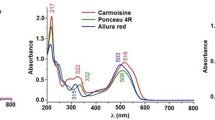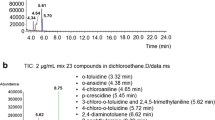Abstract
Food authenticity and food safety are of high importance to organizations as well as to the food industry to ensure an accurate labeling of food products. Respective analytical methods should provide a fast screening and a reliable cost-efficient quantitation. HPTLC was pointed out as key analytical technique in this field. A new HPTLC method applying caffeine-impregnated silica gel plates was developed for eight most frequently found fat-soluble azo dyes unauthorizedly added to spices, spice mixtures, pastes, sauces, and palm oils. A simple post-chromatographic UV irradiation provided an effective sample cleanup, which took 4 min for up to 46 samples in parallel. The method was trimmed to enable 23 simultaneous separations within 20 min for quantitation or 46 separations within 5 min for screening. Linear (4–40 ng/band) or polynomial (10–200 ng/band) calibrations of the eight azo dyes revealed high correlation coefficients and low standard deviations. Limits of detection and quantification were determined to be 2–3 and 6–9 ng/zone, respectively. After an easy sample extraction, recoveries of 70–120% were obtained from chili, paprika, and curcuma powder as well as from chili sauce, curry paste, and palm oil spiked at low (mainly 25–50 mg/kg) and high levels (150–300 mg/kg). For unequivocal identification, the compound in a suspect zone was eluted via a column into the mass spectrometer. This resulted in the hyphenation HPTLC-vis-HPLC-DAD-ESI-MS.

Simplified clean-up by UV irradiation for Sudan dye analysis in food by HPTLC-vis-HPLC-DAD-ESI-MS.





Similar content being viewed by others
References
European Commission. RASFF - Food and Feed Safety Alerts. http://ec.europa.eu/food/safety/rasff_en.
The European Parliament and the Council of the European Union. Regulation (EC) no 178/2002 of 28 January 2002 laying down the general principles and requirements of food law, establishing the European food safety authority and laying down procedures in matters of food safety. Off J Eur Union. 2002;L 31:1–24.
The Comission of the European Communities. Comission decision of 20 June 2003 on emergency measures regarding hot chilli and hot chilli products (2003/460/EC). Off J Eur Union. 2003;L 154:114–5.
The Comission of the European Communities. Commission decision of 23 May 2005 on emergency measures regarding chilli, chilli products, curcuma and palm oil (2005/402/EC). Off J Eur Union. 2005;L 135:34–6.
The Comission of the European Communities. Commission decision of 21 January 2004 on emergency measures regarding chilli, chilli products, curcuma and palm oil (2004/92/EC). Off J Eur Union. 2004;L 27:52–4.
Rebane R, Leito I, Yurchenko S, Herodes K. A review of analytical techniques for determination of Sudan I-IV dyes in food matrixes. J Chromatogr A. 2010;1217:2747–57.
Ferrer Amate C, Unterluggauer H, Fischer RJ, Fernandez-Alba AR, Masselter S. Development and validation of a LC-MS/MS method for the simultaneous determination of aflatoxins, dyes and pesticides in spices. Anal Bioanal Chem. 2010;397:93–107.
Zheng M-M, Wu J-H, Feng Y-Q, Huang F-H. Rapid and sensitive determination of Sudan dyes in hot chilli products by solid-phase extraction directly combined with time-of-flight mass spectrometry. Anal Methods. 2011;3:1851–8.
Erdemir US, Izgi B, Gucer S. An alternative method for screening of Sudan dyes in red paprika paste by gas chromatography-mass spectrometry. Anal Methods. 2013;5:1790–8.
Siangproh W, Sonamit K, Chaiyo S, Chailapakul O. Fast determination of Sudan I-IV in chili products using automated on-line solid phase extraction coupled with liquid chromatography-mass spectrometry. Anal Lett. 2013;46:1705–17.
Genualdi S, MacMahon S, Robbins K, Farris S, Shyong N, DeJager L. Method development and survey of Sudan I-IV in palm oil and chilli spices in the Washington, DC, area. Food Addit Contam Part A. 2016;33:583–91.
Qi P, Zeng T, Wen Z, Liang X, Zhang X. Interference-free simultaneous determination of Sudan dyes in chili foods using solid phase extraction coupled with HPLC-DAD. Food Chem. 2011;125:1462–7.
Enriquez-Gabeiras L, Gallego A, Garcinuno RM, Fernandez-Hernando P, Durand JS. Interference-free determination of illegal dyes in sauces and condiments by matrix solid phase dispersion (MSPD) and liquid chromatography (HPLC-DAD). Food Chem. 2012;135:193–8.
Zhu Y, Wu Y, Zhou C, Zhao B, Yun W, Huang S, et al. A screening method of oil-soluble synthetic dyes in chilli products based on multi-wavelength chromatographic fingerprints comparison. Food Chem. 2016;192:441–51.
Schummer C, Sassel J, Bonenberger P, Moris G. Low-level detections of Sudan I, II, III and IV in spices and chili-containing foodstuffs using UPLC-ESI-MS/MS. J Agric Food Chem. 2013;61:2284–9.
Li J, Ding X-M, Liu D-D, Guo F, Chen Y, Zhang Y-B, et al. Simultaneous determination of eight illegal dyes in chili products by liquid chromatography-tandem mass spectrometry. J Chromatogr B Anal Technol Biomed Life Sci. 2013;942-943:46–52.
Tang B, Xi C, Zou Y, Wang G, Li X, Zhang L, et al. Simultaneous determination of 16 synthetic colorants in hotpot condiment by high performance liquid chromatography. J Chromatogr B Anal Technol Biomed Life Sci. 2014;960:87–91.
Fukuji TS, Castro-Puyana M, Tavares MFM, Cifuentes A. Sensitive and fast determination of Sudan dyes in chilli powder by partial-filling micellar electrokinetic chromatography-tandem mass spectrometry. Electrophoresis. 2012;33:705–12.
Khalikova MA, Satinsky D, Solich P, Novakova L. Development and validation of ultra-high performance supercritical fluid chromatography method for determination of illegal dyes and comparison to ultra-high performance liquid chromatography method. Anal Chim Acta. 2015;874:84–96.
Li Z, Zhang Y-W, Zhang Y-D, Bai Y, Liu H-W. Rapid analysis of four Sudan dyes using direct analysis in real time-mass spectrometry. Anal Methods. 2015;7:86–90.
Cao Y, Fang Z, Yang D, Gao Y, Li H. Voltammetric sensor for Sudan I based on glassy carbon electrode modified by SWCNT/β-Cyclodextrin conjugate. Nano. 2015;10:1550026.
Elyasi M, Khalilzadeh MA, Karimi-Maleh H. High sensitive voltammetric sensor based on Pt/CNTs nanocomposite modified ionic liquid carbon paste electrode for determination of Sudan I in food samples. Food Chem. 2013;141:4311–7.
Chang XC, Hu XZ, Li YQ, Shang YJ, Liu YZ, Feng G, et al. Multi-determination of Para red and Sudan dyes in egg by a broad specific antibody based enzyme linked immunosorbent assay. Food Control. 2011;22:1770–5.
Qi YH, Shan WC, Liu YZ, Zhang YJ, Wang JP. Production of the polyclonal antibody against Sudan 3 and immunoassay of Sudan dyes in food samples. J Agric Food Chem. 2012;60:2116–22.
Zvereva EA, Zaichik BT, Eremin SA, Zherdev AV, Dzantiev BB. Enzyme immunoassay for detection of Sudan I dye and its application to the control of foodstuffs. J Anal Chem. 2016;71:944–8.
Li C, Wu Y-L, Shen J-Z. UPLC-ESI-MS/MS analysis of Sudan dyes and Para red in food. Food Addit Contam Part A. 2010;27:1215–20.
Zhu Y, Zhao B, Xiao R, Yun W, Xiao Z, Tu D, et al. Simultaneous determination of 14 oil-soluble synthetic dyes in chilli products by high performance liquid chromatography with a gel permeation chromatography clean-up procedure. Food Chem. 2014;145:956–62.
Li Y, Wang Y, Yang H, Gao Y, Zhao H, Deng A. Establishment of an immunoaffinity chromatography for simultaneously selective extraction of Sudan I, II, III and IV from food samples. J Chromatogr A. 2010;1217:7840–7.
Piao C, Chen L. Separation of Sudan dyes from chilli powder by magnetic molecularly imprinted polymer. J Chromatogr A. 2012;1268:185–90.
Hu X, Cai Q, Fan Y, Ye T, Cao Y, Guo C. Molecularly imprinted polymer coated solid-phase microextraction fibers for determination of Sudan I-IV dyes in hot chili powder and poultry feed samples. J Chromatogr A. 2012;1219:39–46.
Rajabi M, Sabzalian S, Barfi B, Arghavani-Beydokhti S, Asghari A. In-line micro-matrix solid-phase dispersion extraction for simultaneous separation and extraction of Sudan dyes in different spices. J Chromatogr A. 2015;1425:42–50.
Xu Z, Wang S, Fang G, Song J, Yan Z. On-line SPE coupled with LC for analysis of traces of Sudan dyes in foods. Chromatographia. 2010;71:397–403.
Morlock GE, Brett N. Correct assignment of lipophilic dye mixtures? A case study for high-performance thin-layer chromatography–mass spectrometry and performance data for the TLC–MS Interface. J Chromatogr. 2015;1390:103–11.
Yüce I, Morlock GE. Streamlined structure elucidation of an unknown compound in a pigment formulation. J Chromatogr. 2016;1469:120–7.
Marshall PN. Thin-layer chromatography of Sudan dyes. J Chromatogr. 1977;136:353–7.
Dixit S, Khanna SK, Das M. A simple 2-directional high-performance thin-layer chromatographic method for the simultaneous determination of curcumin, metanil yellow, and sudan dyes in turmeric, chili, and curry powders. J AOAC Int. 2008;91:1387–96.
Guffog S, Brwon PA, Stangroom SG, Sutherland CA. The detection of sudan I, II, III and IV in palm oil by thin layer chromatography. Food Standards Agency Information Bulletin on Methods of Analysis and Sampling for Foodstuffs. 2004; (No. 52).
Kandler H, Bleisch M, Widmer V, Reich E. A validated HPTLC method for the determination of illegal dyes in spices and spice mixtures. J Liq Chromatogr Relat Technol. 2009;32:1273–88.
Morlock G, Kopacz S. Fast and precise SBSE-HPTLC/FLD method for quantification of six polycyclic aromatic hydrocarbons frequently found in water. J Liq Chromatogr Relat Technol. 2008;31:1925–42.
Snyder LR. Classification of the solvent properties of common liquids. J Chromatogr Sci. 1978;16:223–34.
Kowalska T, Kaczmarski K, Prus W. Theory and mechanism of thin-layer chromatography. In: Sherma J, Fried B, editors. Handbook of thin-layer chromatography, 3rd edition (chromatographic science series volume 89). New York: Marcel Dekker; 2003. p. 47–80.
Tsai C-F, Kuo C-H, Shih DY-C. Determination of 20 synthetic dyes in chili powders and syrup-preserved fruits by liquid chromatography/tandem mass spectrometry. J Food Drug Anal. 2015;23:453–62.
Pellissier E. HPTLC-Bestimmung von unerlaubt zugesetzten fettlöslichen Azofarbstoffen in Lebensmitteln: Diploma thesis, University of Applied Science, Western Switzerland/University of Hohenheim, Germany. 2009.
The American Oil Chemists‘ Society Lipid Library, http://lipidlibrary.aocs.org/Analysis/content.cfm?ItemNumber=40339&navItemNumber=19208. AOCS Lipid Library.
Morlock G, Schwack W. Hyphenations in planar chromatography. Journal of Chromatography A. 2010;1217:6600-6609
Oellig C, Schwack W. Strategies of coupling planar chromatography to HPLC–MS. In: Kowalska T, Sajewicz M, Sherma J, editors. Planar chromatography—mass spectrometry (chromatographic science series volume 110). Boca Raton, London, New York: CRC Press; 2016. p. 169–94.
Wang Y, Gu M. The concept of spectral accuracy for MS. Anal Chem. 2010;82:7055–62.
Ruf J, Walter P, Kandler H, Kaufmann A. Discovery and structural elucidation of the illegal azo dye Basic Red 46 in sumac spice. Food Additives & Contaminants: Part A 2012;29:897-907
Acknowledgements
Thank is owed to Merck (Darmstadt, Germany) and Macherey-Nagel (Düren, Germany) for providing HPTLC plates, and to CAMAG (Berlin, Germany) with regard to HPTLC instruments, and to Dr. Claudia Oellig (University of Hohenheim, Germany) for repeating a couple of MS experiments.
Author information
Authors and Affiliations
Corresponding author
Ethics declarations
Conflict of interest
The authors declare that they have no conflict of interest.
Additional information
Published in the topical collection Food Safety Analysis with guest editor Steven J. Lehotay.
Electronic supplementary material
ESM 1
(PDF 0.99 mb)
Rights and permissions
About this article
Cite this article
Schwack, W., Pellissier, E. & Morlock, G. Analysis of unauthorized Sudan dyes in food by high-performance thin-layer chromatography. Anal Bioanal Chem 410, 5641–5651 (2018). https://doi.org/10.1007/s00216-018-0945-6
Received:
Revised:
Accepted:
Published:
Issue Date:
DOI: https://doi.org/10.1007/s00216-018-0945-6




